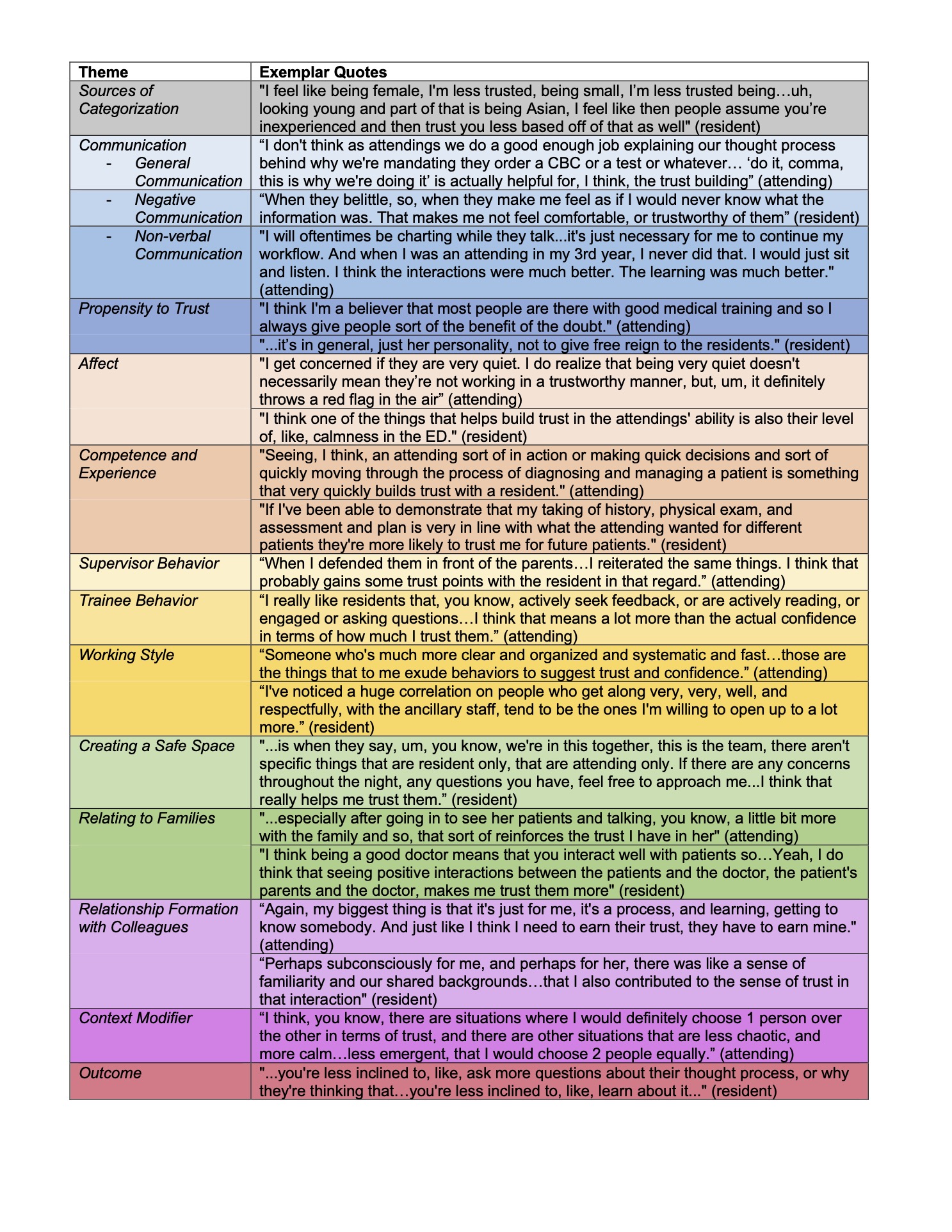Back
Emergency Medicine: All Areas
Category: Abstract Submission
Emergency Medicine VIII
366 - Swift Trust in the Pediatric Emergency Department
Sunday, April 24, 2022
3:30 PM – 6:00 PM US MT
Poster Number: 366
Publication Number: 366.313
Publication Number: 366.313
caroline andler, Children's Hospital Los Angeles, Dana Point, CA, United States; Anita R. Schmidt, Children's Hospital Los Angeles, Los Angeles, CA, United States; Todd P. Chang, Children's Hospital Los Angeles, Los Angeles, CA, United States; Christine S. Cho, Keck SOM of USC, Los Angeles, CA, United States

Caroline F. Andler, MD
Clinical Fellow
Children's Hospital Los Angeles
West Hollywood, California, United States
Presenting Author(s)
Background: Lack of trust between supervisors and trainees, especially in critical scenarios, can have harmful consequences. Trust has been examined between physicians and patients or other staff in multiple settings, but has not been examined in a bidirectional manner between supervisors and trainees in the pediatric emergency department (PED). Debra Meyerson (1996) discussed the theory of Swift Trust, a unique form of trust between temporary groups with limited interpersonal history.
Objective: We aimed to explore the applicability of Swift Trust in the relationship between supervisors and trainees in the PED.
Design/Methods: This multi-methods study used qualitative interviews and the validated Interpersonal Mistrust Trust Measure (IMTM) to assess baseline trusting style. Demographic data were collected. PED attendings from a single institution and residents from various training levels, specialties, and institutions rotating through the same PED were purposively sampled up until thematic saturation. Interviews were analyzed using directed content analysis and inductive coding. IMTM scores were triangulated with interviewee’s reported trusting styles. Further analysis and theming, as well as classification using demographic data, was done using NVivo.
Results: 17 PED attendings and 16 residents (3 specialties, 8 institutions) participated. Residents and attendings placed emphasis on different behaviors that influence trust. Common themes across groups included the impact of one’s affect, the need for vulnerability and appropriate communication, and the influence of trust on self-confidence, learning, and motivation (Table). Most described reliance on certain categories (level of training, specialty, etc) when making trusting decisions. Categories such as gender, race, and sexual orientation were noted to be unimportant when making trusting decisions about others, although some participants believed these attributes played into decisions made by others. Quantitative data from the IMTM supported our qualitative data regarding subject trusting style.Conclusion(s): The trusting relationship between supervisors and trainees in the PED dovetails with the Swift Trust theory in that providers use categories described by Meyerson when making trusting decisions. Common factors that influence trust reveal entry points for intervention for attendings and residents to improve trust, and ultimately prevent negative patient outcomes. Future directions include observational studies looking at how reliance on categories and attributes affect an individual’s trust in their colleagues.
Table 1 Themes and Exemplar Quotes
Themes and Exemplar Quotes
Objective: We aimed to explore the applicability of Swift Trust in the relationship between supervisors and trainees in the PED.
Design/Methods: This multi-methods study used qualitative interviews and the validated Interpersonal Mistrust Trust Measure (IMTM) to assess baseline trusting style. Demographic data were collected. PED attendings from a single institution and residents from various training levels, specialties, and institutions rotating through the same PED were purposively sampled up until thematic saturation. Interviews were analyzed using directed content analysis and inductive coding. IMTM scores were triangulated with interviewee’s reported trusting styles. Further analysis and theming, as well as classification using demographic data, was done using NVivo.
Results: 17 PED attendings and 16 residents (3 specialties, 8 institutions) participated. Residents and attendings placed emphasis on different behaviors that influence trust. Common themes across groups included the impact of one’s affect, the need for vulnerability and appropriate communication, and the influence of trust on self-confidence, learning, and motivation (Table). Most described reliance on certain categories (level of training, specialty, etc) when making trusting decisions. Categories such as gender, race, and sexual orientation were noted to be unimportant when making trusting decisions about others, although some participants believed these attributes played into decisions made by others. Quantitative data from the IMTM supported our qualitative data regarding subject trusting style.Conclusion(s): The trusting relationship between supervisors and trainees in the PED dovetails with the Swift Trust theory in that providers use categories described by Meyerson when making trusting decisions. Common factors that influence trust reveal entry points for intervention for attendings and residents to improve trust, and ultimately prevent negative patient outcomes. Future directions include observational studies looking at how reliance on categories and attributes affect an individual’s trust in their colleagues.
Table 1
 Themes and Exemplar Quotes
Themes and Exemplar Quotes